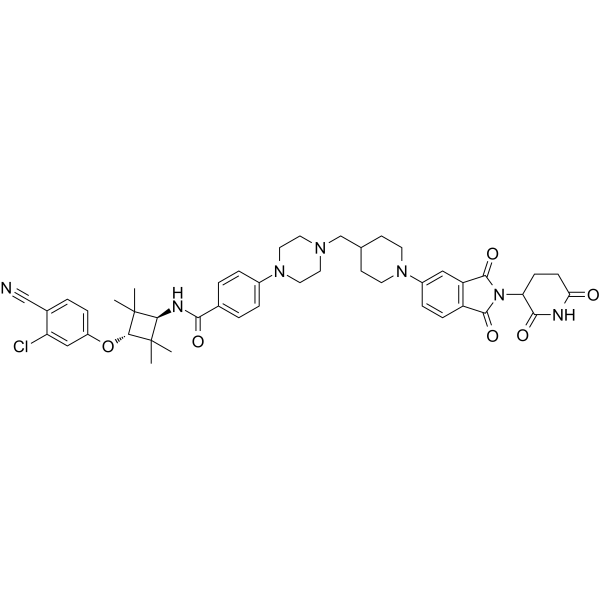| Description |
ARD-2128 is a highly potent, orally bioavailable PROTAC androgen receptor (AR) degrader. ARD-2128 effectively reduces AR protein, suppresses AR-regulated genes in tumor tissues, and inhibits growth of tumor without signs of toxicity. ARD-2128 has the potential for the research of the prostate cancer[1].
|
| Related Catalog |
|
| Target |
IC50: 4 nM (VCaP), 5 μM (LNCaP)[1]
|
| In Vitro |
ARD-2128 is highly potent and effective in the inhibition of cell growth in the VCaP cell line and LNCaP cell line with the IC50 values of 4 nM and 5 nM, respectively[1]. ARD-2128 (1, 10, 100, and 1000 nM; 24 hours) effectively reduces the AR protein level by >50% at 1 nM and achieves the AR degradation of >90% at 10, 100, and 1000 nM, respectively, in VCaP cell[1]. Cell Viability Assay[1] Cell Line: VCaP cell Concentration: 1, 10, 100, and 1000 nM Incubation Time: 24 hours Result: Reduces the AR protein level and achieves the AR degradation.
|
| In Vivo |
ARD-2128 (20 mg/kg; p.o.; once) is effective in reducing the level of AR protein in mice after 24 hours[1]. ARD-2128 (10-40 mg/kg; p.o.; daily for 21 days) shows antitumor activity in the VCaP xenograft model in mice[1]. ARD-2128 (5mg/kg; p.o.) treatment shows the Cmax, AUC0-t and t1/2 values of 1304 ng/mL, 22361 ng h/mL and 18.8 hours, respectively[1]. Animal Model: SCID mice[1] Dosage: 20 mg/kg Administration: Oral Result: Reducing the level of AR protein in mice after 24 hours. Animal Model: SCID mice[1] Dosage: 10, 20, and 40 mg/kg Administration: P.o.; daily for 21 days Result: Inhibits tumor growth by 46, 69, and 63%, respectively. Animal Model: Male ICR Mice[1] Dosage: 5 mg/kg Administration: P.o. (Pharmacokinetic Analysis) Result: The Cmax, AUC0-t and t1/2 were 1304 ng/mL, 22361 ng h/mL and 18.8 hours, respectively.
|
| References |
[1]. Han X, et al. Strategies toward Discovery of Potent and Orally Bioavailable Proteolysis Targeting Chimera Degraders of Androgen Receptor for the Treatment of Prostate Cancer [published online ahead of print, 2021 Aug 25]. J Med Chem. 2021;10.1021/acs.jmedchem.1c00882.
|
